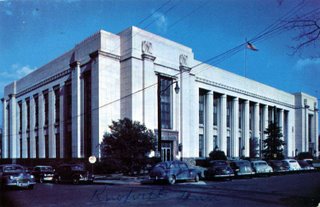Weekend Several: Appalachian Neoclassicism
One of the most intense debates I had with a friend of mine at the University of Virginia, a friend who was from another nation-state, was whether America could claim to have its own culture. She asserted that because our culture was essentially an amalgam of other cultures, we did not. I asserted that by that logic there were probably no more than four or five cultures that could claim that title in human history, since ultimately every single culture was an amalgam of preceding cultures in new and innovative ways, with the key exceptions being incremental changes and new cultural traits based on technological innovations.
 The Post Office and Former Federal Courthouse on Cumberland Avenue, Downtown, in Knoxville, Tennessee
The Post Office and Former Federal Courthouse on Cumberland Avenue, Downtown, in Knoxville, Tennessee (Image from The Swank Pad, which is really fascinating and features a "Best of Knoxville" section worth some serious perusing)
You’re asking yourself, alrighty then Eric, what does this have to do with the task at hand? Well, this debate (circa the autumn of 1999) came to mind today while I sat in the lobby of a bank in downtown Knoxville, Tennessee and looked at the old Federal courthouse and post office. I got into a conversation with my lovely wife about how it was a neoclassical Egyptian design, replete with stylized recreations of Egyptian columns, windows decorated with papyrus and the waves of water (reminiscent simultaneously of the Nile, of course, the grand old Tennessee River), and exterior lights that are reminiscent of the oil burning lamps used in Egyptian temples. This led us into a conversation about how Americans, in our effort to become the third iteration of classical ideals (the first being Greece, Rome, and Egypt, the second being the Renaissance, and the third, contemporary movement being the “neoclassical” or modern period) have actively sought to reiterate classical themes in our architecture in particular – our architecture, of course, intentionally standing as physical manifestations of our political ideals: rationalism, republicanism, democracy, enterprise, liberty, and unity.
Now, as Americans we’ve drawn from many sources that aren’t classical, of course – Indian, Chinese, and Japanese architectural elements have so pervaded our sensibilities since the late 19th Century that we hardly notice them, for instance, not to mention the vast influence of Portuguese and Spanish architecture, which are themselves hugely reminiscent of their one-time rulers the Arab North Africans, particularly in the American West. But the classical ideals of architecture and geography come up over and over again, in our statehouses and in our town names (how many states have a Rome, an Athens, a Memphis, a Carthage, and so forth?).
Well, this led us into a further discussion of classical architecture in Tennessee – the Pyramids of Memphis, for instance, and the Parthenon of Nashville. But could I stop there? Nope. So in lieu of this weekend’s “weekend five,” I decided to seek out Appalachia’s corollaries for the classical, Renaissance, and Enlightenment world’s must-see sites and places. Oh that’s right. You’re gonna’ have to click on ‘m to see if you agree with me. And stuff.
The British Museum
The Coliseum
The Hanging Gardens
The Mausoleum of Halicarnassus
The Pantheon
The Parthenon
The Vatican
or
The Vatican
Versailles
Windsor
(Thanks Mike Mason)
Drop me some knowledge if you can think of alternatives or others we should post. Dammit.




2 comments:
I would like to offer this addition:
Windsor
I don't have an addition to offer but I do think that this is spot on:
"I asserted that by that logic there were probably no more than four or five cultures that could claim that title in human history, since ultimately every single culture was an amalgam of preceding cultures in new and innovative ways, with the key exceptions being incremental changes and new cultural traits based on technological innovations."
Besides, as T.S. Eliot apparently said, talent imitates; genius steals. (paraphrased)
Post a Comment